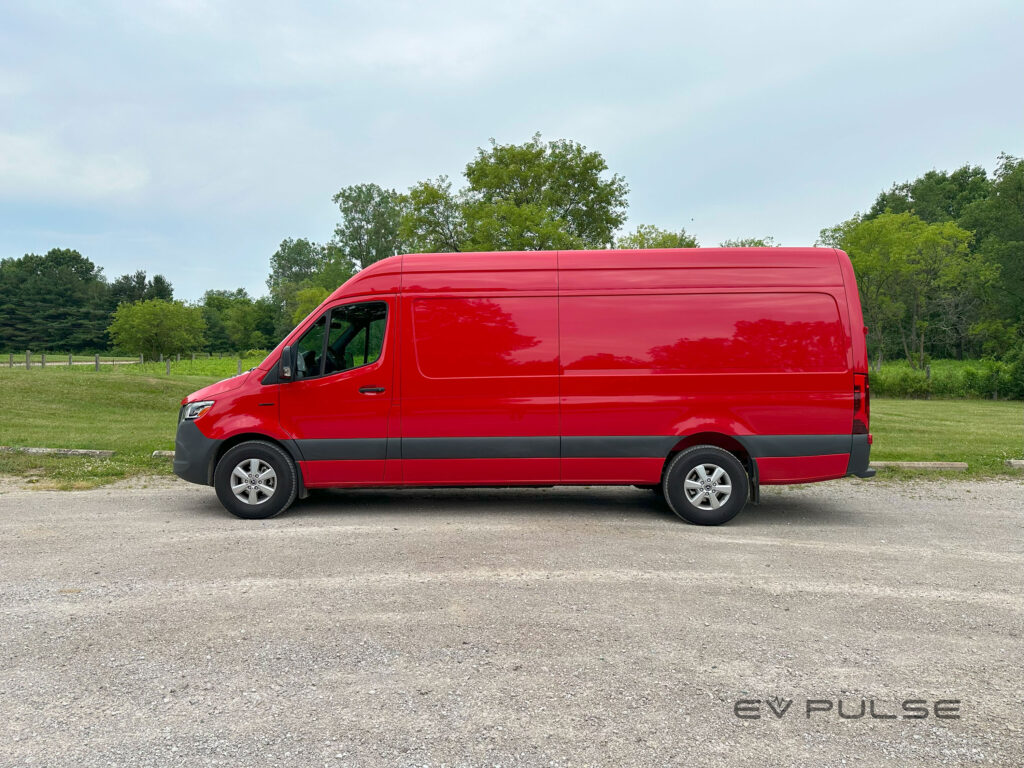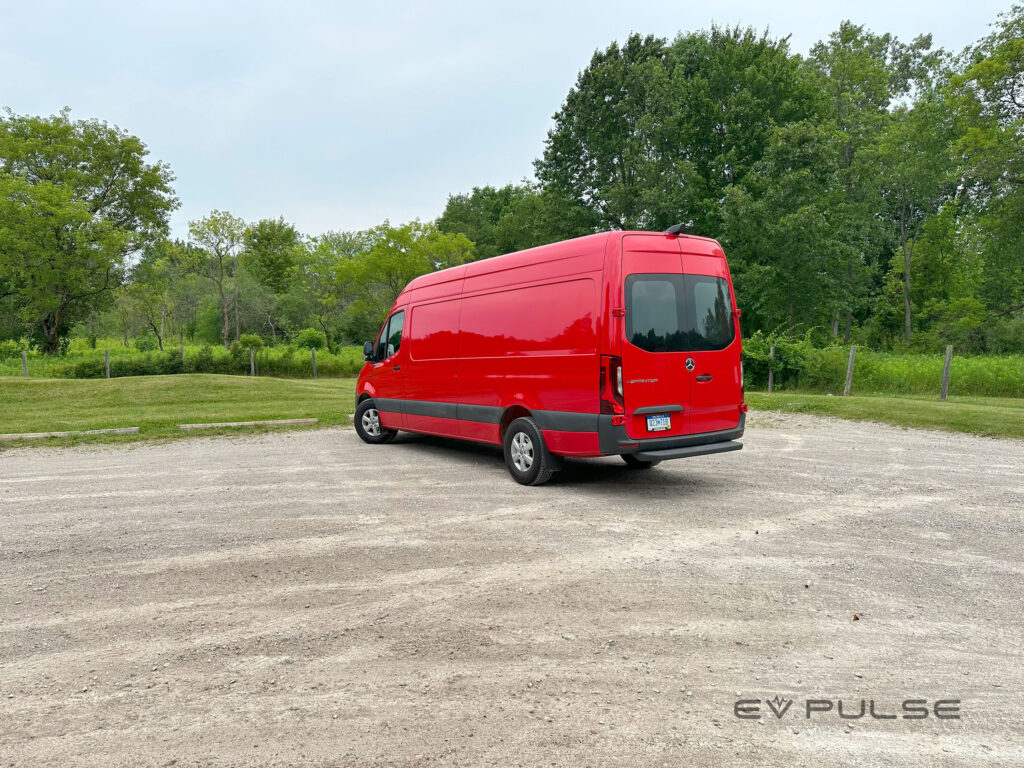Commercial customers looking for an all-electric van have some solid options to choose from. There’s the surprisingly versatile Ford E-Transit, GM has its BrightDrop offerings, you can grab the sleek-looking Rivian EDV, Ram is developing a battery-powered version of the ProMaster, and Mercedes-Benz will happily sell you a 2024 eSprinter. That last option is a well-rounded, hard-working machine that offers a passel of great features in a surprisingly pleasant – but unexpectedly pricey – package.
eSprinter basics
Currently, the eSprinter is offered in just one flavor; you can get it as a cargo model with a high roof, and that’s it. Right now, there’s no short-wheelbase variant or passenger version. Still, that elevated top provides nearly 80 inches of interior height, practically enough to play a game of basketball. Additionally, this van is an incredible 280.4 inches long – more than 23 feet – something that helps provide a staggering 488 cubic feet of space.
Accordingly, the eSprinter can accommodate up to 2,624 pounds in its cavernous cargo hold, considerably less than the E-Transit, though that will be changing for 2025. Still, this Mercedes-Benz has an appropriately husky gross vehicle weight rating (GVWR) of 9,370 pounds.

Underneath the tennis court-sized load floor is alithium-iron-phosphate (LFP) battery pack with 113 kilowatt-hours of usable capacity. Taking advantage of that energy reservoir, the eSprinter is available with either a standard-output drivetrain or a high-output option for $3,430 more. Our tester has the latter, which provides much more horsepower and torque as well as a peak DC fast charging rate of 115 kilowatts, which is substantially quicker than the base model, which tops out at just 50 kW.
Charging performance and range
That peak rate is not all that impressive, but it’s still enough to charge this van’s generously sized battery from 10 to 80% in about 42 minutes, a performance that’s neither great nor terrible; that’s not a good showing for a passenger EV, but it’s perfectly fine for a delivery van. Commercial vehicles probably don’t DC fast charge very often. Instead, they’re more likely to Level 2 charge overnight at a depot, so they’re ready to run in the morning. Accordingly, the eSprinter can take in up to 9.6 kW from an AC power source, enough to juice the battery from a 0% state of charge to 100% in 12 to 13 hours.
When it comes to range, there’s no official estimate, since this is a commercial vehicle, but in testing that’s consistent with the EPA’s methodology, Mercedes-Benz expects the eSprinter to go 206 miles on a full charge, a good bit more than its rival from Ford, which tops out at a blue oval-estimated 159, even after receiving a larger battery for the 2024 model year. As always, of course, your mileage will vary.
Commanding views at a leisurely pace
This van’s available high-output drivetrain provides 201 horsepower and 295 pound-feet of torque to the rear wheels. Even with 440 pounds of ballast strapped down in the back, which Mercedes-Benz included to push the vehicle a little and likely settle the ride (commercial vehicles can be quite starchy when empty), this van has acceptable acceleration and nothing more. This is fine for normal use, as is the 75-mph top speed, but the eSprinter is also rated to tow up to 4,200 pounds, which sounds borderline impossible because of the already-overmatched powertrain.

Like other EVs, this one offers several driving modes. Comfort is the normal setting, Eco limits motor to 100 kW to improve efficiency, and Maximum Range caps the output to just 80 kW and restricts other features to milk as many miles as possible out of the battery. Similarly, drivers have a whopping five regenerative braking settings to choose from, which you can cycle through using steering wheel-mounted paddles. D- provides the strongest regen, D is normal, D+ is light, D++ provides no regeneration and D Auto adapts to changing conditions automatically.
Like other commercial vans, the eSprinter is ponderous and a bit slow, plus the rearward visibility is terrible. While the regenerative braking works perfectly, I wish the brake pedal itself were firmer; it’s so soft under your foot, it almost feels like you’re stepping into a bowl of pudding.
Aside from that, this vehicle’s steering is nimble and the ride firm but settled. Yes, this van always feels huge (you know, because it is), but you do get a commanding view of the road ahead as you tower over just about everything else aside from tractor trailers.
More amenities than you might expect
The eSprinter does what it needs to do when it comes to range, payload and performance, but what really sets this Mercedes-Benz apart from other commercial vehicles is the number of high-end features available. You can get this van with adjustable lumbar support, fog lights that incorporate cornering lamps, automatic high beams are available, a 10.25-inch touchscreen with navigation is on the menu, plus much more.

This vehicle is also offered with plenty of upscale standalone options. You can get 16-inch alloy wheels, a heated windshield to knife through snow and ice in the wintertime, blind spot monitoring and even a rear-view camera mirror, though, both of those latter options should probably be standard in a vehicle with sightlines this compromised.
It’s a steep climb to get inside the eSprinter, but once safely aboard commercial drivers are treated to a surprisingly pleasant cabin. Aside from all those premium amenities, the seats are firm and comfortable, the plastics and other materials look good, and the ergonomics are quite friendly. Even the infotainment system is great, responsive and intuitive, exactly like in a Mercedes-Benz passenger car.
It costs how much?!
When it comes to pricing, I hope you’re sitting down. The 2024 eSprinter’s base MSRP is around $78,000 including $2,295 in delivery fees. Unfortunately, the example shown here is a pre-production model, so there’s no official window sticker, but with all the options and destination, this van should check out for somewhere around $90,000… and that’s a lot of money, especially when you consider the entry-level E-Transit starts around $60,000. Even the base, combustion-powered Sprinter kicks off in the low 50s.
Of course, good things do cost money, and this van’s quality is undeniable, plus it offers loads of great features. Still, the eSprinter does feel a little one-dimensional, since it’s only available in a single configuration. Fortunately, that’s changing for the 2025 model year because Mercedes-Benz is expanding the lineup. You’ll be able to get one of these beasts of burden with a smaller 81-kWh battery pack, there will be a standard roof height formfactor and even a shorter 144-inch wheelbase. These changes should significantly reduce the price and dramatically increase payload capacity, which will top out at 3,516 pounds, a jump of 892 over what our tester can carry.

So, if you’re looking for an electric delivery vehicle or work van and the range meets your needs, the eSprinter is an excellent, if pricey, choice. Examples should be available at dealers right now, though the 2025 model, which promises to be an even better option, is set to go on sale in the second half of the year.
At a glance
- Year: 2024
- Make: Mercedes-Benz
- Trim: eSprinter
- Type: All-electric commercial van
- Horsepower: 201
- Torque: 295 lb-ft
- Manufacturer-estimated range: 206 miles
- Pros: Gargantuan cargo space, available luxury amenities, commanding forward visibility, good charging performance
- Cons: Leisurely acceleration, frightful blind spots, some driver aids should be standard, pricey
- Estimated base price: $78,000
- Estimated as-tested price: $90,000 including $2,295 in destination fees
